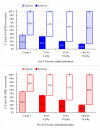Saccharomyces cerevisiae Cell Wall-Based Adsorbent Reduces Aflatoxin B1 Absorption in Rats
- PMID: 33805637
- PMCID: PMC7999883
- DOI: 10.3390/toxins13030209
Saccharomyces cerevisiae Cell Wall-Based Adsorbent Reduces Aflatoxin B1 Absorption in Rats
Abstract
Mycotoxins are naturally occurring toxins that can affect livestock health and performance upon consumption of contaminated feedstuffs. To mitigate the negative effects of mycotoxins, sequestering agents, adsorbents, or binders can be included to feed to interact with toxins, aiding their passage through the gastrointestinal tract (GI) and reducing their bioavailability. The parietal cell wall components of Saccharomyces cerevisiae have been found to interact in vitro with mycotoxins, such as, but not limited to, aflatoxin B1 (AFB1), and to improve animal performance when added to contaminated diets in vivo. The present study aimed to examine the pharmacokinetics of the absorption of radiolabeled AFB1 in rats in the presence of a yeast cell wall-based adsorbent (YCW) compared with that in the presence of the clay-based binder hydrated sodium calcium aluminosilicate (HSCAS). The results of the initial pharmacokinetic analysis showed that the absorption process across the GI tract was relatively slow, occurring over a matter of hours rather than minutes. The inclusion of mycotoxin binders increased the recovery of radiolabeled AFB1 in the small intestine, cecum, and colon at 5 and 10 h, revealing that they prevented AFB1 absorption compared with a control diet. Additionally, the accumulation of radiolabeled AFB1 was more significant in the blood plasma, kidney, and liver of animals fed the control diet, again showing the ability of the binders to reduce the assimilation of AFB1 into the body. The results showed the potential of YCW in reducing the absorption of AFB1 in vivo, and in protecting against the damaging effects of AFB1 contamination.
Keywords: absorption; adsorption; aflatoxin B1; animal health; binder; mycotoxins; yeast cell wall.
Conflict of interest statement
The authors A.Y., G.P.D. and C.A.M. are employees of Alltech which produces and markets Mycosorb®, the commercial adsorbent evaluated in this study.
Figures







Similar articles
-
Efficient Aflatoxin B1 Sequestration by Yeast Cell Wall Extract and Hydrated Sodium Calcium Aluminosilicate Evaluated Using a Multimodal In-Vitro and Ex-Vivo Methodology.Toxins (Basel). 2021 Jan 1;13(1):24. doi: 10.3390/toxins13010024. Toxins (Basel). 2021. PMID: 33401432 Free PMC article.
-
Prevention of maternal and developmental toxicity in rats via dietary inclusion of common aflatoxin sorbents: potential for hidden risks.Toxicol Sci. 1998 Feb;41(2):175-82. doi: 10.1006/toxs.1997.2405. Toxicol Sci. 1998. PMID: 9520353
-
Modification of aflatoxin B1 and ochratoxin A toxicokinetics in rats administered a yeast cell wall preparation.Food Addit Contam Part A Chem Anal Control Expo Risk Assess. 2010 Aug;27(8):1153-60. doi: 10.1080/19440041003801174. Food Addit Contam Part A Chem Anal Control Expo Risk Assess. 2010. PMID: 20512710
-
Aflatoxin B1: Challenges and Strategies for the Intestinal Microbiota and Intestinal Health of Monogastric Animals.Toxins (Basel). 2025 Jan 17;17(1):43. doi: 10.3390/toxins17010043. Toxins (Basel). 2025. PMID: 39852996 Free PMC article. Review.
-
The efficacy of mycotoxin binders to control mycotoxins in feeds and the potential risk of interactions with nutrient: a review.J Anim Sci. 2022 Nov 1;100(11):skac328. doi: 10.1093/jas/skac328. J Anim Sci. 2022. PMID: 36208465 Free PMC article. Review.
Cited by
-
Ameliorative effect of nanocurcumin and Saccharomyces cell wall alone and in combination against aflatoxicosis in broilers.BMC Vet Res. 2022 May 14;18(1):178. doi: 10.1186/s12917-022-03256-x. BMC Vet Res. 2022. PMID: 35568841 Free PMC article.
-
Comparative Assessment of Different Yeast Cell Wall-Based Mycotoxin Adsorbents Using a Model- and Bioassay-Based In Vitro Approach.Toxins (Basel). 2023 Jan 24;15(2):104. doi: 10.3390/toxins15020104. Toxins (Basel). 2023. PMID: 36728779 Free PMC article.
-
Risk-Benefit Assessment of Feed Additives in the One Health Perspective.Front Nutr. 2022 Feb 10;9:843124. doi: 10.3389/fnut.2022.843124. eCollection 2022. Front Nutr. 2022. PMID: 35223963 Free PMC article. Review.
-
Synthesis and characterization of aluminosilicate and zinc silicate from sugarcane bagasse fly ash for adsorption of aflatoxin B1.Sci Rep. 2024 Jun 24;14(1):14562. doi: 10.1038/s41598-024-65158-2. Sci Rep. 2024. PMID: 38914625 Free PMC article.
-
Current Approaches to Aflatoxin B1 Control in Food and Feed Safety: Detection, Inhibition, and Mitigation.Int J Mol Sci. 2025 Jul 7;26(13):6534. doi: 10.3390/ijms26136534. Int J Mol Sci. 2025. PMID: 40650309 Free PMC article. Review.
References
-
- Yiannikouris A., Jouany J.-P. Mycotoxins in feeds and their fate in animals: A review. Anim. Res. 2002;51:81–99. doi: 10.1051/animres:2002012. - DOI
-
- CAST . Mycotoxins: Risks in Plant, Animal, and Human Systems. Council for Agricultural Science and Technology; Ames, IA, USA: 2003.
Publication types
MeSH terms
Substances
LinkOut - more resources
Full Text Sources
Other Literature Sources
Medical

